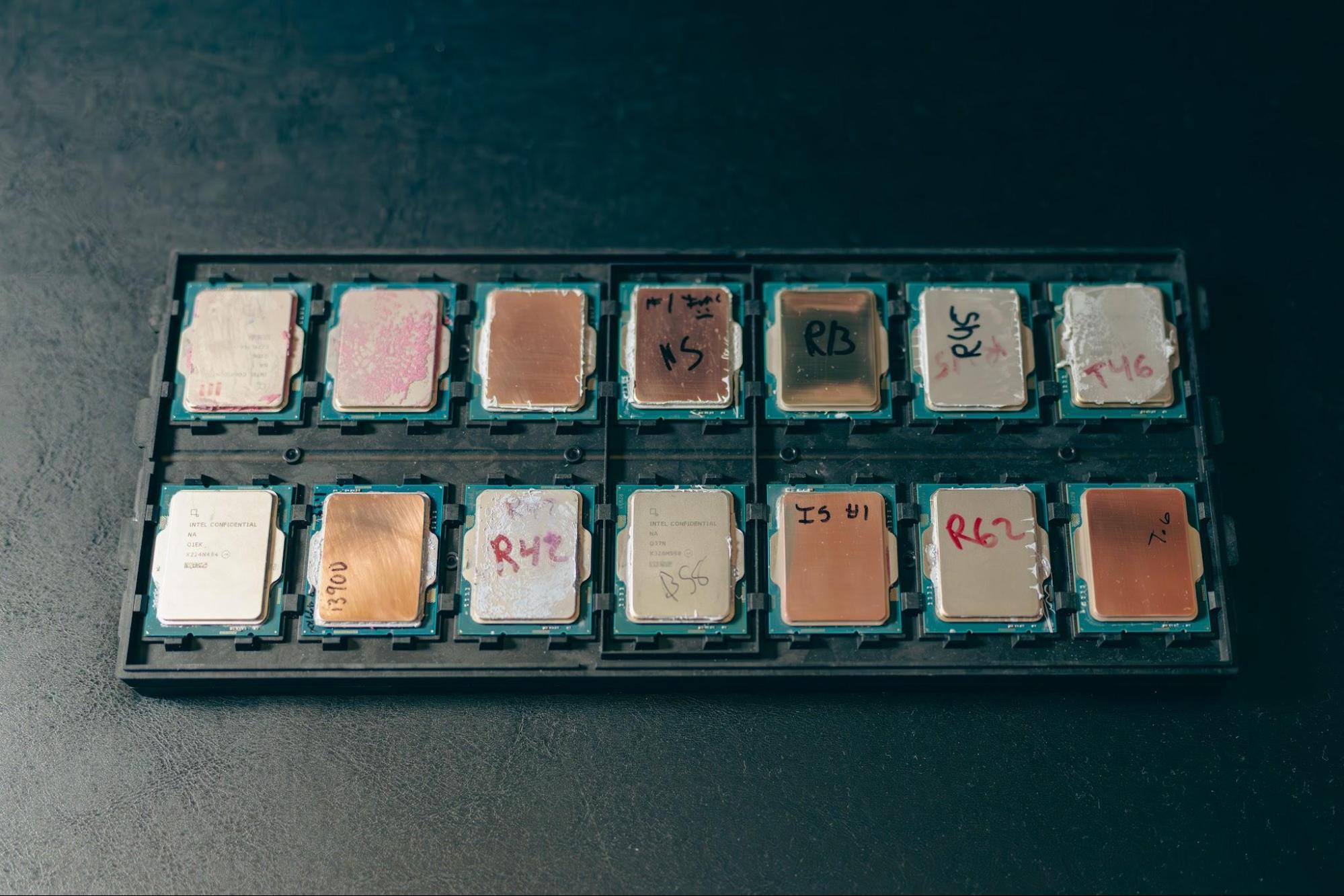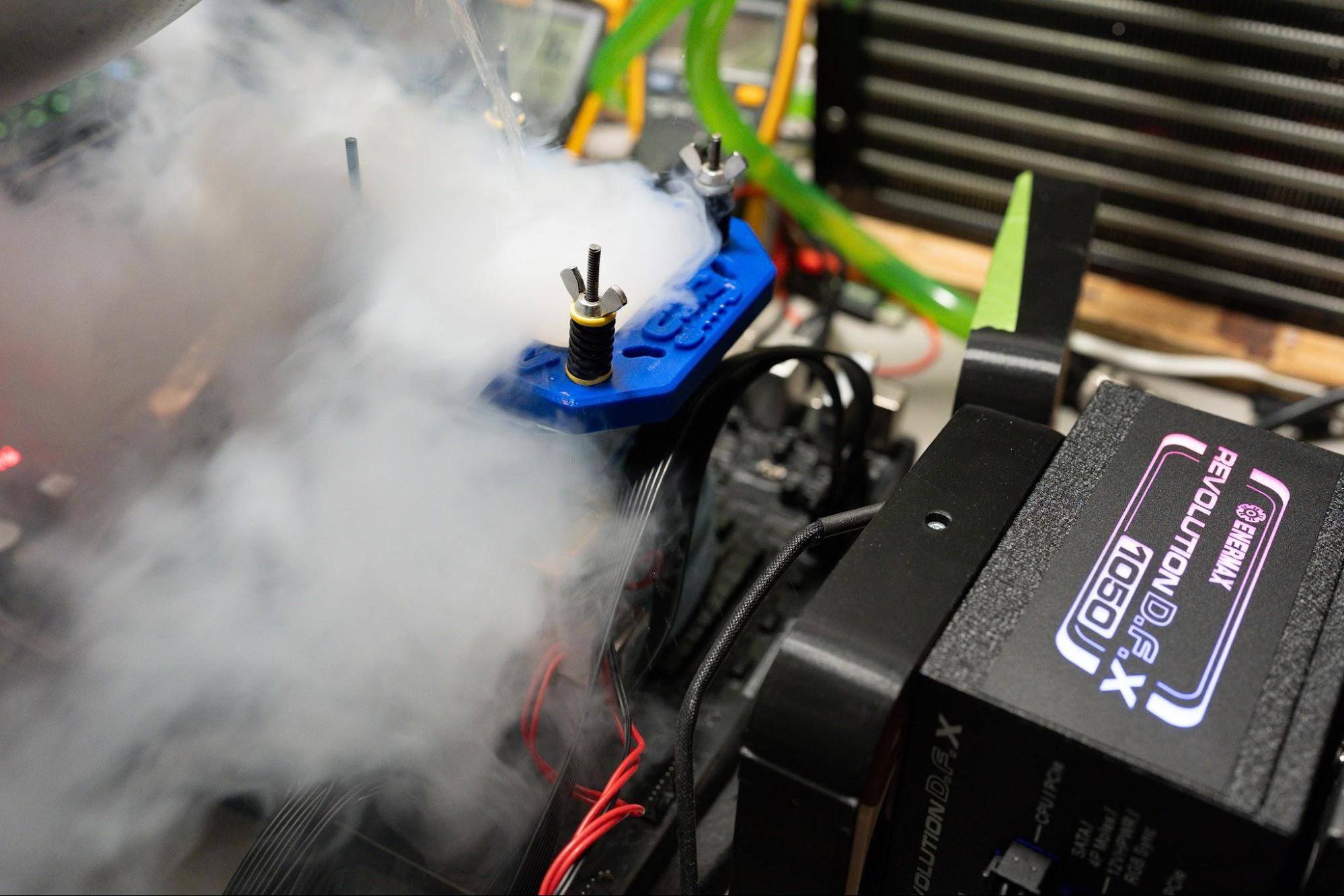14900K at 7.7 GHz: How I Set 50 Overclocking Records with Intel's Raptor Lake Refresh CPUs and Plenty of Liquid Nitrogen
The Core i7-14700K and Core i5-14600K also overclocked nicely.

Welcome back to the fun factory, aka, my basement computer lab — the realm where the exceptional becomes the standard. Today's journey will explore the extreme side of overclocking, focused mainly on the PC's brain, the processor. I recently nailed a total of 50 world records with Intel’s 14th Gen "Raptor Lake Refresh" CPUs. Many of those still stand as of this writing (people are always posting new ones to HWBot), including 15 world records with the Core i7-14700K and eight records with the Core i5-14600K, along with four records with the Core i9-14900K, spanning benchmarks from Cinebench to wPrime and H265.
My top speeds were 7,730.11 MHz on all cores on the 14900K, 7,859.05 MHz on the 14600K and 7,600 MHz on the 14700K. All of these achieved in Cinebench R23 while using Liquid Nitrogen cooling.
| CPU | Maximum Clock (All-Core) | Stock Max Speed | Cores / Threads |
|---|---|---|---|
| Core i9-14900K | 7,730.11 MHz | 6,000 MHz | 24 (8P + 16E) / 32 |
| Core i7-14700K | 7,600 MHz | 5,600 MHz | 20 (8P + 12E) / 28 |
| Core i5-14600K | 7,859.05 MHz | 5,300 MHz | 14 (6P + 8E) / 20 |
The hero of the day? Intel's new baby is the Raptor Lake Refresh processors, led by the Core i9-14900K. The current newest flagship for the mainstream (will we get KS, maybe?) is clocked high out of the box, so what have they left for us to find on our own? Is this processor, as the kids say, a “smooth brain” or a “wrinkle brain?” Let’s find out.
“OC is dead!” some cry. Well, yes and no. Intel is pushing the turbo hard on these processors, which works great. Pushing upwards of 6 GHz was a dream not even a year ago, and it is seemingly the new standard. “But that's not on all cores.” Well, even I “cheat” the limits of the system by running an asynchronous per-core clock ratio on LN2. Why limit yourself to your weakest core?
I think OC is changing. Depending on your motherboard and how they set up power and temperature limits, you can see a solid performance uplift from strapping on better cooling and changing nothing at all! You don't even have to go into the BIOS, but there is a feature in most BIOS now called Intel Current Limits. Many manufacturers have this disabled, even at stock settings. So, if you aren't following the Intel current limits, is your motherboard “overclocking” for you? If OC is dead, why is this even an option? Maybe you are an overclocker, and you don't even know it!
Let’s overclock! For full transparency, I have many close relations in the PC industry, and several sources provided these CPUs. They should be considered higher quality than a normal random draw. That being said, six out of six ran Cinebench R23 at 5.9 GHz on water cooling with all cores synced, and five out of six ran Cinebench R23 at 6.0 GHz on water cooling with all cores synced. Yes, 6 GHz!
The 14900K is seemingly just a better 13900K, right? At the same MSRP, is that a win? If you are offered a better car for the same price a year later, is that a good deal? Is this especially true in the 2020s era /covid/greed/inflation?
Get Tom's Hardware's best news and in-depth reviews, straight to your inbox.
So, with fully manually controlled settings with no turbo and a fixed clock rate, the 14900K is the same as the 13900K as far as performance is concerned. Great. In this case, that means to break records, we will need pure clock speed enhancements. Maybe we will see a 7.19424% increase in clocks (13900K percent gain to 14900K)?
For my record-setting attempts, I use my trusty ASRock Z690 Aqua OC motherboard. It’s a two-DIMM board for better memory overclocking, which helps the benchmarks we commonly run score higher than with a four-DIMM board. It’s about a little over a year old and still runs strong. Why not a Z790 motherboard if I have access to whatever I want? Well, to me, Z790 is just a different name for the same thing, much like the 13900K is to the 14900K.
The ENERMAX Revolution D.F. X 1050W ARGB powers the system. It’s 80-plus Gold, it’s tiny, and the cables are super bendy so that I can keep them out of the way of all my fans and LN2 containers easily. It handles the system on LN2 with no sweat.
For memory, I always choose G.SKILL. These are their DDR5 Trident Z5 7800 MHz RGB sticks in Silver. When pushing the limits, you need any edge you can get. A little lower latency or extra bandwidth can take you from silver to gold. That's why I use G.SKILL and their higher frequency kits. Love it or hate it, the RGB looks great and adds 100 points to my Cinebench scores (just kidding).
With my star-studded branded powerhouse of a system slapped together, we can finally work up an overclock. Cinebench R20, although aging now, seems to be the industry standard for OC measurement, so I usually start there. It’s also a fairly long, consistently high-load test. It really tests your cooling equipment, like the CPU LN2 container and thermal paste. I'm using Der8auer’s Thermal Grizzly Kryonaut thermal paste currently and a Reaktor CPU container.
These CPUs don't like very high voltage: It generates too much heat and creates a downward spiral of high wattage, high temps, and general inefficiency. We want to run as cool as possible with as little voltage as possible, with clocks as high as possible for strong scoring and efficiency. For perspective, the max voltage I consider using with normal cooling (AIO, etc.) is around 1.4-1.45V. This would get you into the 100C area, and possibly thermal throttling at the very high end.
On LN2, I’m only using +200mV more than that. Many think these are throw-away CPUs and garbage after being used on LN2, but that is far from the truth – the CPU will last countless sessions in these conditions. It is actually rare for me to kill or wound hardware, and when I do, I take it as a personal failure. I have a small graveyard in my backyard where I do a short service to pay my respects to fallen hardware heroes.
Here are some extra little tidbits for you: When the CPU pot is full, the temperature probe reads -192C. When I start the benchmark, it will reach as high as -189C, fighting against the cold face of the CPU pot filled with liquid nitrogen. The actual die temperature will be much higher than that.
Frozen thermal paste is not the best conductor, and some strong forces work against each other in that weak layer. Sometimes, the cold will overwhelm the thermal paste, and it will either crack or separate itself from one side of what it is supposed to be cooling. In that case, it will become more of an insulator than a conductor, and nothing will run.
The CPU will reach a positive temperature even though the metal container millimeters away from it is an insane -190C. When this happens, you have to tear everything apart and start over. It’s a mess, and a total timesuck. Luckily, this only happened once during my benching session, and it was my fault.
At the end of a week of playing around, I broke the 8-core Cinebench record at a crazy 7.73 GHz on all cores! In total, I managed over 50 records between the i5, i7, and i9 processors that were refreshed. They are a breeze to overclock and really fun to work with. Overall, these CPUs potentially OC better than their predecessors and cost the same. It was a rather refreshing refresh, I would say.
Disclosure: ASRock, Enermax, Intel, G.Skill, and Thermal Grizzly contribute to my overclocking success.

A world-champion competitive overclocker who frequently tops the charts at HWBot, a site which tracks speed records, Allen will do just about anything to push a CPU to its limits. He shares his insights into the latest processors with Tom’s Hardware readers from a hardcore, push-it-to-the-limit overclocker’s perspective.
-
Vanderlindemedia Is VRM switching frequency still a thing these days? The higher, the less voltage you need. At least that's my experience. Ive done some good OC'ing in the past with a Vapochill and such onto a CPU, GPU, applied mods and even managed to get a crazy 120% OC going from 600Mhz on a 2600Pro all the way up to 1330Mhz on a frying 2.2V.Reply -
thestryker I'm curious when doing asynchronous ratios do you actually try to optimize the clocks on the lower ratios? If so what do you use to validate them?Reply
My current setup is relatively ancient so my clocks aren't really pushed terribly far apart so it was pretty easy. It seems like doing a variable ratio overclock today would be pretty time consuming though I haven't had opportunity to test it myself.






